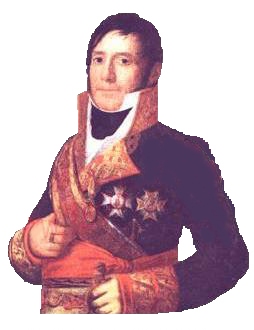Gabriel de Mendizábal Iraeta facts for kids

Gabriel de Mendizábal Iraeta (born May 14, 1765, in Bergara, Gipuzkoa – died September 1, 1838, in Madrid) was a brave Spanish general officer. He is famous for fighting in the Peninsular War. This war was a big conflict in Spain and Portugal. Mendizábal became a general even though he wasn't born into a rich, noble family. He earned his way up in the army.
Contents
Early Military Career
Gabriel de Mendizábal started his military journey as a sergeant major. His first battle was during the War of the Pyrenees. This war took place between Spain and France. Mendizábal fought in different areas, including the Basque-Navarrese and Catalan regions.
In 1793, he was promoted to Colonel. He was given command of a new group of soldiers called the Voluntarios de Burgos. They were stationed in northern Portugal.
A Victory in His Hometown
Later, in 1794, Mendizábal was moved to western Gipuzkoa. He was given a lower rank after a military problem in Irún. But on December 2, 1794, he led a group of local fighters. These fighters were from Álava, Gipuzkoa, and Biscay. Together, they won an unexpected victory against French troops in his own hometown of Bergara.
In 1802, Mendizábal became a Colonel again. He took charge of a group of volunteers from Navarre. On September 23, 1804, he marched his troops into Bilbao. His mission was to stop a series of riots known as the Zamacolada.
Rising Through the Ranks
When the Peninsular War began in 1809, Mendizábal was promoted to mariscal de campo. This rank is similar to a major general. Later that year, he was given a special noble title: "Conde de Cuadro de Alba de Tormes." He earned this title for his military successes against the French cavalry. In 1810, he continued to rise, becoming a Lieutenant General.
The Battle of the Gebora
Mendizábal was put in charge of the Army of the Left. However, he suffered a big defeat at the Battle of the Gebora. Because of this loss, he was removed from command. Feeling very ashamed, Mendizábal asked to serve as a regular soldier. His request was granted.
A Comeback and New Command
He showed great bravery at the Battle of Albuera in May 1811. Because of his actions, he was given back his command. He became the leader of the Seventh Army, also known as the "Séptimo Exército." He led this army to northern Spain. This area included the Basque Provinces (Biscay), Navarre, La Rioja, Burgos, and Santander. In this mountainous region, he used clever fighting methods called guerrilla tactics. These tactics involve small groups of fighters making surprise attacks.
Political Role and Final Battles
On December 16, 1812, Mendizábal was named the political chief of the Seigneury of Biscay. He called a meeting of the local council, the Council of Biscay. They sent a group to Cádiz to discuss a new Constitution.
In the final stages of the war, on August 31, 1813, he commanded one of the divisions. This was during the very important and bloody Battle of San Marcial. For his brave actions, he received the highest military awards. These included the Laureate Cross of Saint Ferdinand and the Laureate of the Royal and Military Order of Saint Hermenegild.
After the War
From 1814 to 1820, Gabriel de Mendizábal gained important political power. He became a member of the Consejo Supremo de la Guerra, which was a high military council. In 1834, he was named president of the Tribunal Supremo de Guerra y Marina. This was a top court for military and navy matters. He held this important position until he passed away four years later in 1838.
See also
 In Spanish: Gabriel de Mendizábal para niños
In Spanish: Gabriel de Mendizábal para niños

